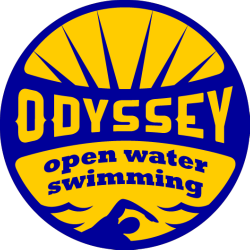Odyssey Open Water Swimming Berkeley Swim Briefing
Prior to each Berkeley swim, our swim leader gives a short briefing to swimmers. These briefings start promptly at the time the swim is scheduled to begin. Swimmers can expect to enter the water about 15 minutes after the posted start time. Please reference this briefing before joining us on an upcoming Berkeley swim.
For any new open water swimmers, here are a few tips:
The biggest challenge for many new open water swimmers is the psychological aspect. Keep in mind that even if you feel a little anxious at any time during the swim, this is a very safe situation. We have a safety boat on the water, there are several of us on kayaks keeping an eye on you, and there are no currents pulling you out. Also, it’s not a race, and you can take your time as needed. Feel free to stop and relax and get acclimated. If you need anything, please let us know!
Like any long distance swim, you’ll want to swim differently than you might for a short pool swim. Make sure you are reaching far and stretching out your stroke.
Stay steady and consistent—a lot of people get a little frantic and swing their arms or do other things that cut down on efficiency.
Get a lot of breath—even if you can go 20 strokes without breathing, it will catch up to you later in the swim. Every two to four strokes is usually good to keep your body performing well for a long period of time.
Sighting is one of the big challenges for new open water swimmers. Because we don’t have the line on the bottom of the pool to look at, we need to lift our eyes up out of the water to make sure we are still going the right way. Try to make the motion as minimal as possible, because lifting your head high or holding it up for a long time will cause your hips to drop in the water and cut back on efficiency. How often you sight is up to you; some people do it every six or seven strokes, but some wait 30 strokes or more. Just keep in mind that the more you zig-zag, the longer you are swimming!
We will be sighting for large colored buoys, but sometimes it is hard to see them quickly, so it helps to find other markers in the background to look for.
Let’s look at the swim for today…
We have these colored buoys that we set up in different places for different swims, to keep it interesting (coach will point out where they are today).
There is a GoPro attached to the first buoy. If you want to take a photo of yourself, just push the button on top, do not push any other buttons. It’s on and ready to use. We’ll post the photos on social media. (Note: the buoy cameras will not be available in March and early April)
The course is set up so that swimmers of any level of experience can do distances that work for them (coach will show different distance options).
You should do whatever distance you’re comfortable with—we have swimmers who regularly do less than half a mile, and a few who often go two or more.
When you finish the swim, make sure to tell the coach your name, even if you think he/she already knows it. This is important for safety.
Besides distance, you should also go whatever speed you feel comfortable with. Don’t worry if you feel like you’re way behind or way ahead of everyone. Some people go all out and time themselves, some people go slowly and stop to enjoy the scenery. Whatever you’re comfortable with. If you get tired and want to float on your back for a minute, that’s totally ok!
And the conditions for today...
(Coach will go over temperature) It gets as cold as 50 during the winter months but has gotten as warm as 73 during summer months
(Coach will go over wind and waves) Some days it is completely flat, but other days there are fairly large waves. If it is choppy, remember to stay calm and consistent. It is sometimes helpful to do shorter and faster strokes.
(Coach will go over time, including whether or not it is deep enough to jump in from the dock and if swimmers will be able to touch the bottom) If it is shallow, swimmers should avoid touching the bottom as much as possible. There are some shells and rocks on the ground around the dock, and swimmers have cut their feet before.
Odyssey swim support crew will be out in the boat and on the kayaks or paddleboards if you need anything.
Staff is there in case of an emergency.
They are also available if you need anything else, like if you want to hold onto the kayak and relax for a minute or need someone to hold onto your cap, goggles, etc.
Don’t hesitate if you need anything!
It’s important that swimmers are familiar with our safety signals. Sometimes to make sure you’re ok, one of the swim support paddlers will use the head patting motion if you’re too far away to talk to. If you’re ok and do not need help, repeat this motion. The paddler will come to you if you use any other hand motion. Waving arms and calling for help is the best way to get the support crew’s attention if you need help.
Have questions? Email alex@odysseyopenwater.com.


